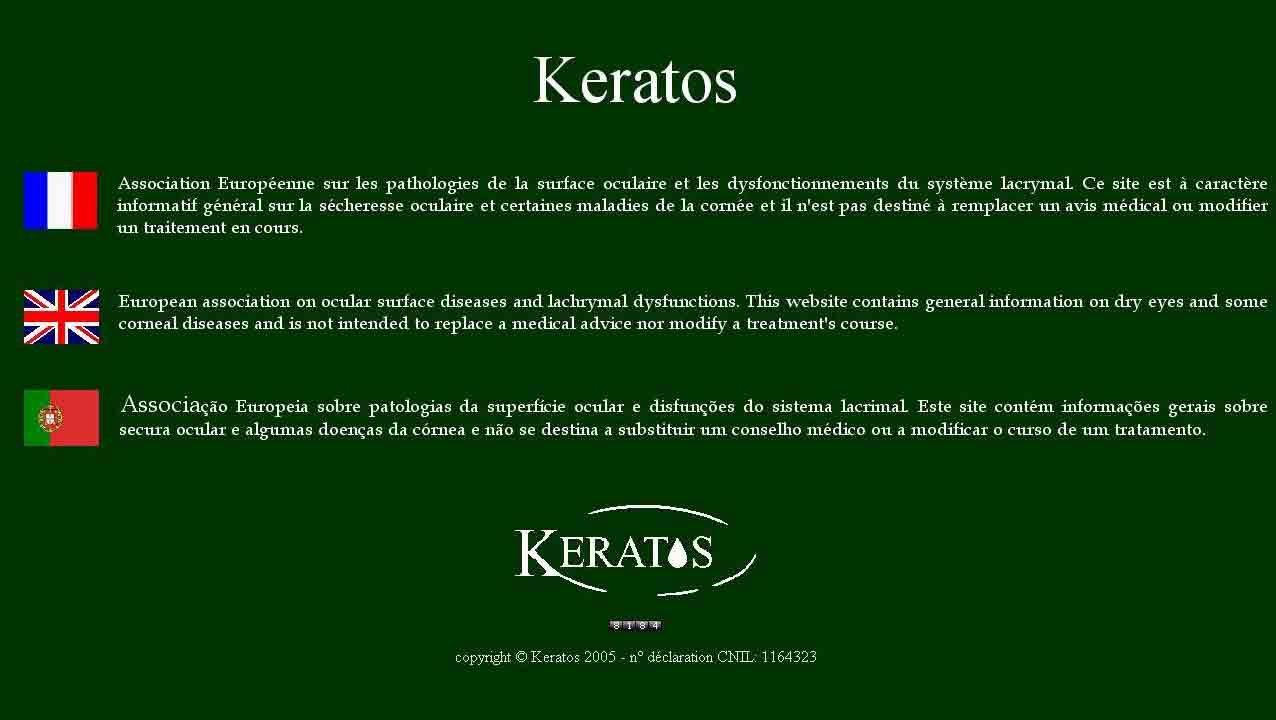Contacto
Este site contém informações de ordem geral sobre os riscos criados pelos
conservantes oculares nos colirios, cremes e geles oftálmicos.
No entanto, ele não se destina a substituir o conselho médico nem a modificar o
curso de um tratamento.

Keratos
é uma organização sem ânimo de lucro baseada em França, mas com
delegações em Portugal, na Bélgica e na Noruega sobre patologias da
superficie ocular et disfunções lacrimais (como a secura ocular).
Trata-se de uma associção de pacientes, regido pelo direito francês, que
procura fornecer a, e proporcionar melhores tratamentos àqueles que
padecem de patologias da superficie ocular.
Queremos agradecer as contribuicões
de: Dotanne (Nueva Zelanda), Luísa
(Portugal), Neil y Matt (EUA), Steve (Canadá),
Toril (Noruega) . Dedicamos este sitio a todas as
vítimas dos conservantes oculares.
Clique sobre a imagem para ter acesso
ao nosso site principal.
Abaixo uma lista de estudos sobre os
conservantes:
Sites:
http://www.guideline.gov/summary/summary.aspx?ss=15&doc_id=3549&nbr=2775
http://www.iovs.org/cgi/content/full/42/3/642
http://www.iovs.org/cgi/reprint/25/12/1453.pdf
http://www.knowledgeofhealth.com/blog/2001_09_01_archive.html
http://www.ingentaconnect.com/content/mksg/cod/2005/00000052/00000006/art00008
http://www.medscape.com/viewarticle/512387_4
http://www.ncbi.nlm.nih.gov/entrez/query.fcgi?db=pubmed&cmd=Retrieve&dopt=AbstractPlus&list_uids=16900358&query_hl=1&itool=pubmed_docsum
http://www.optometric.com/article.aspx?article=71748
http://www.eyeworld.org/article.php?sid=3583
http://www.dryeyezone.com/talk/showthread.php?t=2460
http://www.ncbi.nlm.nih.gov/entrez/query.fcgi?db=pubmed&cmd=Retrieve&dopt=AbstractPlus&list_uids=17003409&query_hl=7&itool=pubmed_docsum
http://www.ncbi.nlm.nih.gov/entrez/query.fcgi?db=pubmed&cmd=Retrieve&dopt=AbstractPlus&list_uids=16799018&query_hl=1&itool=pubmed_docsum
http://www.clspectrum.com/article.aspx?article=13025
http://www.aios.org/proceed2003/External/Ext11.pdf
http://www.medscape.com/viewarticle/512387_References
http://www.pharmcast.com/Patents100/Yr2005/Sept2005/092705/6949241_Eye092705.htm
http://www.chinadaily.com.cn/english/doc/2005-08/04/content_466206.htm
http://www.iovs.org/cgi/content/abstract/47/7/2812
http://www.revoptom.com/index.asp?ArticleType=SiteSpec&page=osc/feb01/lesson_0201.htm
http://www.ncbi.nlm.nih.gov/entrez/query.fcgi?db=pubmed&cmd=Retrieve&dopt=AbstractPlus&list_uids=17172885&query_hl=13&itool=pubmed_docsum
http://www.ingentaconnect.com/content/tandf/orbi/1999/00000018/00000002/art00003?crawler=true
http://dev.expertsmtl.com/cme4/mediconcept/Noecker.pdf
http://www.ncbi.nlm.nih.gov/entrez/query.fcgi?itool=abstractplus&db=pubmed&cmd=Retrieve&dopt=abstractplus&list_uids=7742279
http://www.ophmanagement.com/article.aspx?article=86656
Etudes:
Graefes
Archive for Clinical Experimental Ophthalmology. 2006 Aug 10;
Comparative study of topical anti-allergic eye drops on human
conjunctiva-derived cells: responses to histamine and IFNgamma and
toxicological profiles. Pauly A, Brignole-Baudouin F, Guenoun JM,
Riancho L, Rat P, Warnet JM, Baudouin C. U598, INSERM, Cordeliers
Biomedical Institute, 15 rue de l'ecole de medecine, 75006, Paris,
France.
Prevalence of ocular
symptoms and signs with preserved and preservative free glaucoma
medication. Pisella PJ, Pouliquen
P, Baudouin C.APHP Ambroise Pare Hospital, University Paris V,
Ophthalmology Department, 9, avenue Charles de Gaulle, 92100 Boulogne,
France.
A
comparative study of the ocular tolerance after administration of
anti-allergic eye drops with or without a preservative
[Article in
French] Beden C, Helleboid L, Marmouz F, Liard F. Societe Naxis, Lyon,
France.
Comparison of the
Short-Term Effects on the Human Corneal Surface of Topical Timolol
Maleate With and Without Benzalkonium Chloride. Journal of Glaucoma.
12(6):486-490, December 2003. Ishibashi, Takeshi MD; Yokoi, Norihiko MD,
PhD; Kinoshita, Shigeru MD, PhD.
Effect of benzalkonium chloride on the stability of the precorneal tear film in rabbit and man.
WS Wilson, AJ Duncan and JL Jay. 1975 by the British Journal of Ophthalmology.
Preservative-free artificial tear preparations.
Assessment of corneal epithelial toxic effects . G. J. Berdy, M. B.
Abelson, L. M. Smith and M. A. George. Eye Research Institute,
Massachusetts Eye and Ear Infirmary, Harvard Medical School, Boston.
Corneal toxicity
secondary to inadvertent use of benzalkonium chloride preserved viscoelastic material in cataract surgery.
Eleftheriadis et al.
Br. J. Ophthalmol. 2002;86:299-305.
Allergy and preservatives. Apropos of 3 cases of allergy
to benzalkonium chloride
Chiambaretta F,
Pouliquen P,
Rigal D. Service d'Ophtalmologie,
Hopital Gabriel-Montpied, CHRU, Clermont-Ferrand: J Fr Ophtalmol.
1997;20(1):8-16
Solving the Preservative Paradox. Better packaging for nonpreserved tears is the answer. BY HERBERT L.
GOULD M.D., F.A.C.S.
Prevalence of ocular symptoms and signs with preserved
and preservative free glaucoma medication.P
J Pisella1,2, P Pouliquen3 and C Baudouin1,4
.1 APHP Ambroise Paré Hospital, University
Paris V, Ophthalmology Department, 9, avenue Charles de Gaulle, 92100 Boulogne, France.
2
Bretonneau University Hospital, Ophthalmology Department, 2, boulevard
Tonnellé, 37044 Tours Cedex 1, France. 3 Théa Laboratories,
12, rue Louis-Blériot, - ZI du Brézet, 63017 Clermont-Ferrand, Cedex 2,
France,4 XV-XX National Hospital, University Paris V, 28, rue de
Charenton, 75012 Paris, France
Br J Ophthalmol 1998;82:39-42
( January )Short term comparative study of topical 2% carteolol with and
without benzalkonium chloride in healthy volunteers
Christophe Baudouin,a
Christine de Lunardob
Br J Ophthalmol 1998;82:39-42 ( January )
Short term comparative study of topical 2% carteolol with and
without benzalkonium chloride in healthy volunteers.
Christophe Baudouin,a
Christine de Lunardob
a Department of Ophthalmology, Ambroise Paré,
University of Paris-V René Descartes, France, b Center
of Clinical Pharmacology, Pasteur Hospital, University of Nice, Francea Department
of Ophthalmology, Ambroise Paré, University of Paris-V René Descartes,
France, b Center of Clinical Pharmacology,
Pasteur Hospital, University of Nice, France
Quaternary Ammoniums and Other
Preservatives’ Contribution in Oxidative Stress and Apoptosis on Chang
Conjunctival Cells
Caroline Debbasch1,2,
Françoise Brignole3, Pierre-Jean Pisella1,2,
Jean-Michel Warnet1, Patrice Rat1 and Christophe
Baudouin2
1 From the Unit of Cellular Pharmacotoxicology, Centre
Hospitalier National d’Ophtalmologie des Quinze-Vingts, the Toxicology
Laboratory, University of Paris-V; and the 2 Ophthalmology
and 3 Immunohematology Services, Hôpital Ambroise Paré,
Assistance Publique–Hôpitaux de Paris, University of Paris-V, Boulogne,
France.
Impact
of short-term exposure of commercial eyedrops preserved with
benzalkonium chloride on precorneal mucin, So-Hyang Chung,1 Su Kyung
Lee,1 Stephen M. Cristol,2 Eun Suk Lee,3 Dong Wook Lee,4 Kyoung Yul
Seo,1 Eung Kweon Kim1,5.
Cha SH,
Lee JS, Oum BS, Kim CD. Corneal epithelial cellular dysfunction from
benzalkonium chloride (BAC) in vitro. Clin Experiment Ophthalmol
2004;32(2):180-4.
RegeneRx's TB4 Subject of Four Presentations at 2005 ARVO Meeting;
Researchers Present New Data Indicating TB4 May Reduce Deleterious
Effects Associated with Chronic Use of Eye Drops, Business Wire, May 2,
2005.
Investigative Ophthalmology and Visual Science. 2006 Jul; 47(7):2812-9. Fluoroquinolone eye drop-induced cytotoxicity: role of preservative in
P2X7 cell death receptor activation and apoptosis.*
Dutot M,* Pouzaud F, * Larosche I,*
Brignole-Baudouin F,* Warnet JM,* Rat P.Laboratoire de Toxicologie,
Faculte des Sciences Pharmaceutiques et Biologiques, Université Rene
Descartes-Paris, and Centre Hospitalier National d'Ophtalmologie des
Quinze-Vingts, Paris, France.
Au-delà des collyres::
Call
for worldwide withdrawal of benzalkonium chloride from nebulizer
solutions. Journal of Allergy and Clinical Immunology, Volume
107, Issue 2, Pages 222-223 R. Beasley
Benzalkonium chloride in a decongestant nasal spray
aggravates rhinitis medicamentosa in healthy volunteers. Clin Exp
Allergy.1995; 25:957-965
Benzalkonium chloride induces mucosal swelling, which explains why the
presence of this preservative in a decongestant spray aggravates
nasal/sinus symptoms
Effects of topical nasal steroids on human respiratory mucosa and human
granulocytes in vitro. Steinsv¡ag S. Acta Otolaryngol (Stockh),
116(6):868-75 1996
"It is concluded that benzalkonium chloride has toxic effects on human
respiratory mucosa and human neutrophils in vitro."
Effect of topical corticosteroids and topical antihistaminics on ciliary
epithelium of human nasal mucosa in vitro. Hofmann T. HNO, 46(2):146-51
1998 Feb
"An irreversible cessation of ciliary movement was observed in all cells
exposed to nasal sprays containing benzalconium chloride....." "we
recommend that this preservative should not be used anymore in topical
nasal medications."
The effects of topical nasal steroids on rat respiratory mucosa in vivo,
with special reference to benzalkonium chloride. Berg OH. Allergy,
52(6):627-32 1997 Jun
"In conclusion, benzalkonium chloride appears to be potentially toxic to
the nasal mucosa."
O essencial deste site
está apenas disponível em
francês e inglês. incluímos esta apresentação em
portugês para facilitar a compreensão do tema.
Caso
precise de informações suplementares ou queira entrar em contacto
conosco é favor contactar-nos email em português ou español: Contacto
Keratos Portugal
É favor ler o resto do site em
francês
 ou inglês
ou inglês  .
.
▲

copyright ©
Keratos 2007